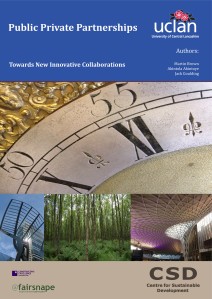Our recent publication
“Towards New Innovative Collaborations”
exploring PPP Public Partnerships and Collaborative Working within the changing built environment sector, is now available through Amazon
Extracts from the publication follow …
Introduction
This report presents an industry perspective and context of Public Private Partnerships (PPP), the discussion of which is supported by evidence from extant literature, current thinking, and through a recent Public Private Partnership Body of Knowledge International Conference in 2013, hosted by the University of Central Lancashire, Grenville-Baines School of Architecture, Construction and Environment, in conjunction with the research Centre for Sustainable Development (CSD).
This report highlights the key issues needed for industry stakeholders involved in Public-Private Partnership research. It also provides additional insight into CIB TG 72: Public-Private Partnerships for Research and Development. The report is structured around core priorities and emergent themes in PPP research, the main issues of which include the following areas:
- The historical and current context of PPP and collaborative working from Building Down Barriers to 2013 Construction Strategy
- Industry perspectives on PPP developments;
- Key themes and outcomes arising out of the PPP Industry Day
- The scope, reach and impact of international and industrial engagement through social media in relation to Public Private Partnerships.
Headlines
- Public Private Partnerships need to emerge as collaborative, knowledge sharing, innovative and purpose-driven partnerships …
- Defining value, creating value and measuring value within and across Public Private Partnership projects is not fully understood by all…
- There is a need for research and academic organisations to play a key role in Public Private Partnership projects to drive continuous improvement…
- Building Information Modelling changes everything – from procurement, to collaborative working, to technology and innovation. This will undoubtedly change Public Private Partnerships…
- Public Private Partnerships need to be seen as relevant to all sectors of the built environment …
- Social Media and open sharing is an emerging and critical dimension for knowledge sharing, engagement and improvement…
- Future Research and Development in the Public Private Partnerships arena should address issues outlined within this report…
INTRODUCTIONS
Martin Brown, Advocate and Consultant at Fairsnape Chair, Lancashire Construction Best Practice Club / CE Collaborative Working Champion “Our built environment collaborative working journey is now venturing into new territories. The future for a responsible built environment will increase both the pressure and opportunities beyond collaboration and partnerships to co-collaborate and co-create hybrid projects, moving to open innovations that in turn stimulate further opportunities. Such new and emerging agendas include social responsibility, managing increasingly scarce resources in purpose-driven circular economies, addressing restorative sustainability, adopting transparency and meeting the challenges of BIM and social media connectivity”…
“We believe that the innovations required to create the future won’t come from a single source. Not from science. Not from technology. Not from governments. Not from business. But from all of us. We must harness the collective power of unconventional partnerships to dramatically redefine the way we thrive in the future.” Hannah Jones, Nike’s Global Head of Sustainability and Innovation
John Lorimer, JLO Innovations, Local Authority BIM Liaison Officer, Construction Industry Council. “A successful Partnership is one that comes together and delivers more than the sum of its parts. Understanding how collaborative business relationships actually work, defining the benefits, articulating and sharing that with Industry and Clients are a significant challenge” …
“Changes are always coming and innovations such as BIM will act as a driver of effective integration of the supply chain. BIM is probably the biggest single change to hit the Industry in the past 50 years. Partnership working skills aren’t new, but they must be refocused to fit today’s delivery processes, including the use of BIM” (John Lorimer keynote at #PPPConf2013).
Don Ward Chief Executive, Constructing Excellence. We believe a number of improvements can be made to the process to improve value-for-money through collaborative working, ten years ago we identified that the process should consist of the following: identify and develop a business need; appoint the best team (not a worked-up solution) using award criteria focussed on evidence of predictability of outcome measures; agree a target cost (‘unitary payment’); value engineer with pain-gain share to arrive at an optimum solution; deliver and operate the solution with continuous improvement and equitable sharing of financial savings over the concession period” …
Professor Akintola Akintoye Dean, Grenfell-Baines School of Architecture, Construction and Environment, UCLan “The need for innovation through procurement strategies is now more important than ever before. The industry is faced with the need to deliver enhanced value for money, with increasingly complex projects, enhanced competition, and additional pressures to comply with legislative demands and requirements (e.g., sustainable development). Innovative construction procurement methods have developed out of these new demands, and have helped to improve risk management, value for money etc; and these new methods are now transforming the industry” …
Partnerships in Construction – A Reflection
Partnering and collaborative working relationships are considered the most important vehicle for successful project delivery, the rubrics of which have been embedded in many international construction strategies. This highlights the importance of working together to not only achieve successful project outcomes, but also the collaborative infrastructure required to fully leverage an integrated and resilient client/supply chain to deliver real ‘value’ to PPPs.


Pingback: Do we really need ‘Green BIM’? | fairsnape isite